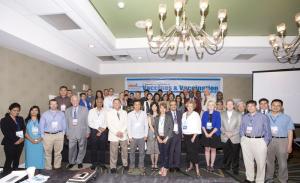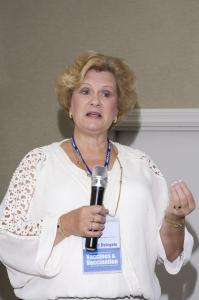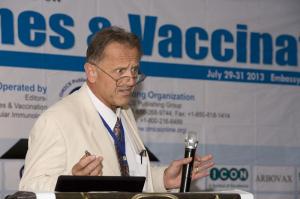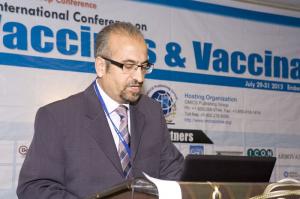Vaccinating for a Disease Free society - OMICS Group Clinical Conferences
3rd International Conference on Vaccines & Vaccination during July 29-31, 2013 at Las Vegas, USA reflected the importance of the disease free society.
LOS ANGELES, CA, USA, July 30, 2013 /EINPresswire.com/ -- The term Vaccine is derived from a Latin origin and vaccine is a biological preparation meant to build immunity against a particular disease. Vaccine is an agent that resembles the disease causing icroorganism. It is generally prepared from the toxin or the surface protein of the weakened or the killed icroorganism. Once injected, vaccine stimulates the immune system of the body and trains it to recognize any foreign agent that enter the body quickly and fights back to it effectively.Edward Jenner, that invented a vaccine for small FOX was first to use this word in 1796. Today, we can vaccinate and immune our bodies against several diseases like Polio, Measles, Diphtheria, Hepatitis, Yellow fever and even dreadful HIV/AIDS. Diseases like Polio have been completely eradicated and no young boy or girl is affected with it.
OMICS Group’s 3rd International Conference on Vaccines & Vaccination during July 29-31, 2013 at Embassy Suites Las Vegas, USA reflected the importance of the disease free society.
Vaccines-2013 served as a scientific platform to academic institutions, healthcare institutes, pharmaceutical and biotech companies, CROs, vaccine developers, supply chain and logistics providers to share their experiences and foster collaborations. There were Oral and poster presentations and panel discussions with novel, practical and thought provoking vaccine designs & vaccination strategies from around the world.
Eminent speakers and their contributions:
Peter-L.-Nara- Biological Mimetics, Inc, USA, delivered keynote address on "Decoding immune evading mechanisms of pathogens: Reordering of immunodominance for new and improved vaccines". He explained the importance of vaccines over centuries on the way they remained as a mainstay of preventative medicine and public health that was successful and cost-effective medical interventions ever discovered. He recollected that despite these great advances to human and animal health for the past 5 decades; the basic technology on which it was created from does not for the most part work against the many remaining pathogens of humans and animals. This is mainly due to evolved immune evading strategies making them inherently resistant due to strain-restricted immunity/antigenic variation/poor memory/disease-enhancement/incomplete and/or shortened immunity and thus represents a major gap in our understanding of the complex evasion mechanisms evolved by the pathogens. "Deceptive Imprinting" is at the heart of a new understating of how mutable pathogens create a molecular diversion (decoy) at the level of both the innate and acquired immune host defense systems-- much like how metallic chaff would confuse a radar system trying to locate a missile or plane. This lecture brought a new paradigm shift in the first principals of Deceptive Imprinting, immunology and added new insight from querying pathogen genomes through “Pressure Point” Technology and application of the technology of Immune Refocusing. This have opened up fresh new approaches to technical advancement and the development of new antigens that can be used for vaccines and deriving new monoclonal antibodies toward inducing improved and broader protective immunity.
Ara Hovanessian, CNRS Universite Paris Descartes, France, presented his case on “The Achilles heel in HIV-1: The conserved caveolin-1 binding domain in the transmembrane envelope glycoprotein gp41 is a B- and T-cell epitope target for vaccine development. He observed that generation of a broadly effective vaccine against HIV-1 is complicated due to the extremely fast level of mutation of its genomic sequence, and the high degree of variability between various viral clades. Consequently, a conserved functional sequence in the HIV genome may represent the "Achilles' heel" of HIV for the development of an efficient vaccine. He recollected the way the scientists have been working on this by quoting the sequences in 1997-1998 about the discovery of nucleoli that exists at the cell surface where it serves as a low affinity receptor for various growth factors and microorganisms including HIV-1. Further studies using equilibrium density fractionation using sucrose gradient of Triton X-100 extracts from freshly HIV-1 infected cells, revealed the coexistence of viral matrix, gp41. Caveolin-1 is constitutively expressed in cells but being cholesterol binding protein it is insoluble in non-ionic detergents. Consequently the presence of caveolin-1 with the HIV-1 replication complex indicates its Triton X-100 solubilisation during the HIV-1 entry process. He concluded say that they have identified a distinct caveolin-1 binding motif in in the ectodomain of gp41 which is conserved in every single HIV-isolate, 623WNNMTWMEW631.This strong conservation as well gp41 binding to caveolin-1, suggest that there is a constant selective pressure to preserve this sequence for a specific function in the HIV infectious cycle. By a series of studies, he said that they demonstrated that the
Robert E. Sievers from University of Colorado, USA presented a paper on “Stabilization and drying of vaccines for novel delivery”. His presentation demonstrated how stabilizing, gentle drying and packaging of vaccine as micro particles offer advantages in terms of efficacy and safe administration of vaccine. He proved how aqueous suspensions of Edmonston-Zagreb measles vaccine stabilized with myo-inositol, then gently dried at 50 – 60 ºC by Carbon Dioxide Assisted
Nebulization with a Bubble Dryer yielded microparticles with 1-5 microns aerodynamic diameter. They are later delivered effectively from individually sealed blister packs into aerosol bags and then delivered throughout respiratory tracts without reconstitution in water The microparticles deposit on the moist surface are rapidly dissolved to initiate development of a mucosal immune response. Within a few
days, after inhalation of the dry powder aerosol vaccine by rhesus macaques, measles virus-specific antibodies were detected, and after 13 months the macaques receiving aerosols from reservoirs attached to masks were fully protected when challenged with wild-type measles virus. The immune response was at least as robust as that from subcutaneous injection of liquid vaccine into non-human primates.
The delivery of dry powder aerosols eliminates the need of water for reconstitution to be supplied or carried to the field as is necessary for conventional reconstitution of freeze-dried vaccines. Contamination of multi-dose vaccine vials can be avoided and the hazards of accidental needle sticks and dirty needles are avoided by mucosal aerosol administration.
De-chu C. Tang of International Vaccine Institute, Korea through his report titled “ Adenovirus vector-induced innate-adaptive protective immunity duo against viral and bacterial infections” claimed that intranasal administration of adenovirus serotype 5 (Ad5)-vectored influenza vaccine could induce seroconversion in human volunteers without appreciable adverse effects, even in subjects with pre-existing Ad5 immunity. Moreover, the DE1E3 Ad5 particle itself without transgene could confer rapid prolonged-broad protection against a variety of influenza virus strains by inducing an anti-influenza state in a drug-like manner, conceivably by activating a specific arm of innate immunity.
Ad5’s capacity to rapidly induce an anti-influenza state, an Ad5 vector encoding a bioengineered Bacillus anthracis protective antigen (PA) could also confer rapid (e.g., 1-2 days) prophylactic or post-exposure anthrax therapy with synergy to antibiotic treatment in a murine model.
Through a paper titled "Design and clinical evaluation of a novel self-adjuvanting peptide-based pan influenza A T-cell vaccine", Campbell Bunce, from Immune Targeting Systems Ltd, UK demonstrated how Immune Targeting Systems (ITS) has developed a rationally designed, safe, self-adjuvanting vaccine technology that induces robust cell mediated immune (CMI) responses to peptide antigens. The vaccine concept is based on linking a fluorocarbon chain to long immunogenic peptides. These ‘fluoropeptides’ bearing specific physicochemical properties spontaneously form micelles in solution and enhance immunogenicity by the formation of an in vivo short-term depot thereby allowing efficient exposure of peptide antigens to the immune system. From the clinical studies, Flunisyn™ was demonstrated to be safe and well tolerated across young and old members of the population, inducing a broad cross-reactive anti-viral CMI response to multiple, distinct influenza viruses (H1N1 to H9N2). These properties offer the unique position for Flunisyn™ as a truly pan-influenza vaccine for seasonal and pandemic use. Flunisyn’s ability to induce a robust immune response in the elderly population is of particular importance where conventional, HA-based influenza vaccines have proven to be poorly effective.
Benjamin Petsch, CureVac GmbH, Germany, presented a paper on "Protection against influenza from RNActive® technology". He argued that messenger RNA based vaccination is a novel and promising vaccination approach.
He mentioned about CureVac’s RNActive® technology that provided effective two-component mRNA-based vaccines with self adjuvanting activity and promising results were generated with RNActive® vaccines in the field of cancer immunotherapy in preclinical and clinical settings. He wanted to investigate the use of RNActive® technology to generate vaccines protecting against infectious diseases, using influenza virus infection as an example. Experiments conducted on mice showed that an mRNA vaccine based on the influenza hemagglutinin (HA) elicited outstanding protective efficacy against challenge infections. It was possible to demonstrate this protective efficacy for several human strains of influenza (H1N1, H3N2) and for highly pathogenic H5N1 viruses when the corresponding hemagglutinin was part of the mRNA vaccine (homologous protection).
These results are extremely promising as regards the pursuit of innovative RNActive® vaccines for seasonal influenza and potential new approaches in the area of vaccination against infectious diseases.
WORKSHOP
Brenda S. Atchison, Executive Director, the Alliance for Multispecialty Research LLC and her team hosted a workshop on “Implementing a core team process to maximize efficiencies and minimize costs in the start-up and conduct of clinical trials.
Sponsor: GenPhar Inc., USA
Exhibitor: Desert King International, USA
Conference Highlights:
• Innate and Adaptive Immune Responses to Vaccination
• Vaccinations Focusing on Induction of B or T cell Responses
• Novel Approaches in Design of Cellular and Molecular-Based Vaccines
• Vaccines Against Infectious Diseases and Cancers
• Manufacturing, Production, and Development of Vaccines
• Regulatory and Ethical Issues of Vaccines and Public Acceptance
• Translational, Clinical Evaluation and Field Trials of Vaccines
• Modern Technologies in Vaccine Discovery and Development
• Age-specific Immune Response to Vaccination
Future OMICS Group Conference on Vaccines & Vaccination:
OMICS Group 4th International Conference on Vaccines & Vaccination (Vaccines-2014) will be held on September 23-25, 2014 Valencia, Spain.
For further details contact
Venkatesh kothapally
Vaccines-2014-Organizing Committee
Clinical Conferences
5716 Corsa Ave | Suite110
Westlake, Los Angeles
CA-91362-7354, USA
Email: vaccines2014@omicsonline.us / vaccines2014@omicsgroup.com
Office +1- 650-268-9744, +1-800-216-6499 (USA & Canada)
Fax +1-650-618-1414
Venkatesh kothapally
OMICS Group Incorporation
+1- 650-268-9744
email us here





